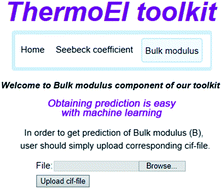Predictive analytics for crystalline materials: bulk modulus†
Abstract
The bulk modulus is one of the important parameters for designing advanced high-performance and thermoelectric materials. The current work is the first attempt to develop a generalized model for forecasting bulk moduli of various types of crystalline materials, based on ensemble predictive learning using a unique set of attributes. The attributes used are a combination of experimentally measured structural details of the material and chemical/physical properties of atoms. The model was trained on a data set of stoichiometric compounds calculated using density functional theory (DFT). It showed good predictive performance when tested against external DFT-calculated and experimentally measured stoichiometric and non-stoichiometric materials. The generalized model found correlations between bulk modulus and features defining bulk modulus in specific families of materials. The web application (ThermoEl) deploying the developed predictive model is available for public use.


 Please wait while we load your content...
Please wait while we load your content...